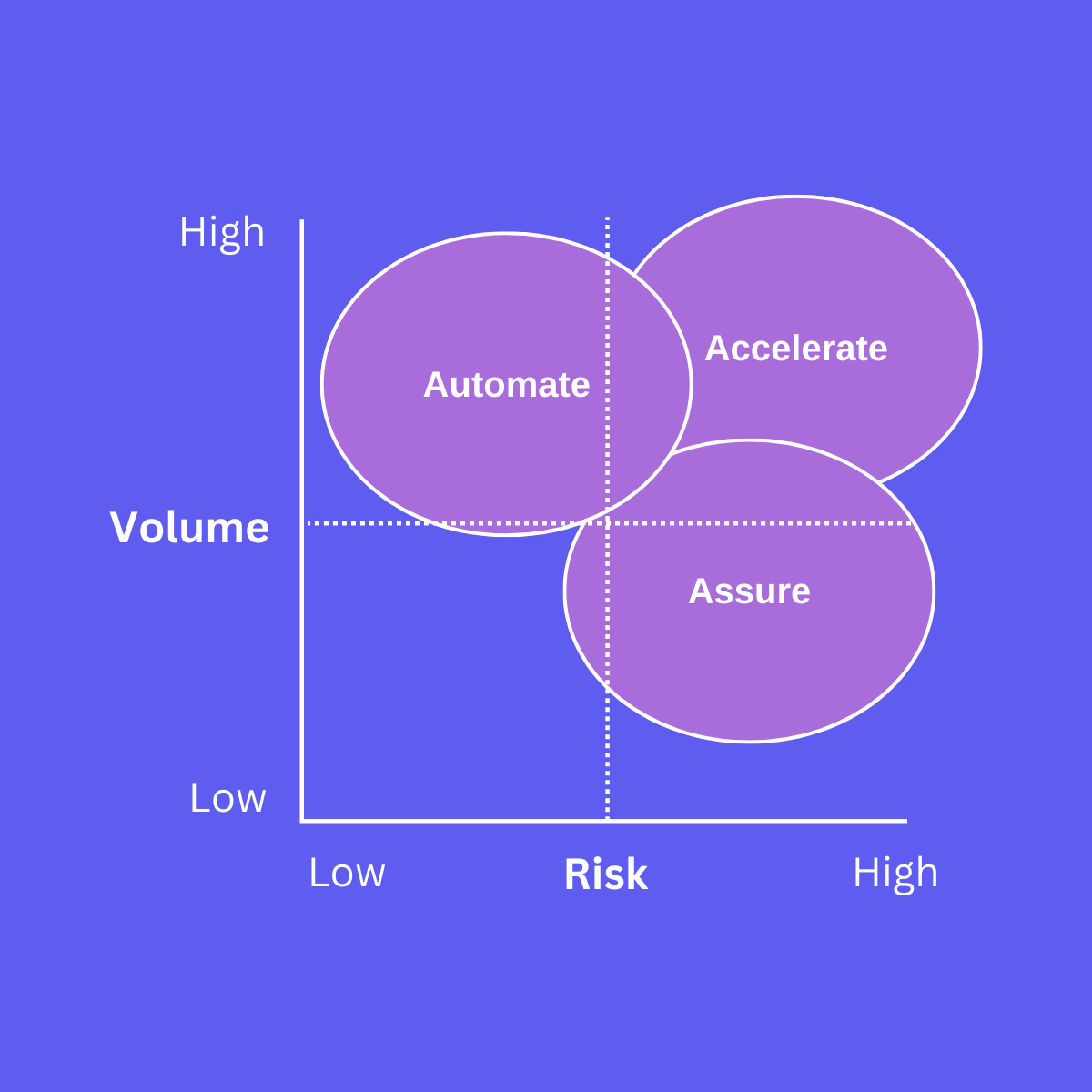
How to Detect a Legal AI Opportunity
Uwais Iqbal • 2022-12-07
Where can AI solutions be applied in legal workflows? This article introduces a 5-step framework for identifying and articulating Legal AI Opportunities.
A question which often comes up in conversation is ‘How do I know if Legal AI can be used in my work as a legal professional?’ or ‘Where can Legal AI be used in legal?’.
We’ve put together a simple 5-step framework that will help you detect and identify opportunities where Legal AI solutions can be developed and deployed in your legal workflows.
This 5-step framework empowers you to go from not really understanding what Legal AI is and how it can be used, to uncovering Legal AI Opportunities for yourself in your own workflows.
5-step Framework for Detecting Legal AI Opportunities
Here is the 5-step framework to help you identify and detect Legal AI Opportunities:
Step 1 - Identify the Legal AI Context
Step 2 - List out the jobs to be done
Step 3 - Identify any jobs which involve a Legal AI Action
Step 4 - Determine the Legal AI Function
Step 5 - Articulate the Legal AI Opportunity
Let’s explore each of the steps in more detail.
Step 1 - Identify the Legal AI Context
The first step is to identify the context of where Legal AI should be applied based on the legal use case and problem vertical. Within legal, there are different contexts and problem verticals:
- Due Diligence
- eDiscovery
- Contract Review
- Contract Repapering
- Legal Research
- Litigation
Identifying the Legal AI Context will help capture the bigger picture of where Legal AI can be applied.
Step 2 - List out the jobs to be done
We have to start with a very intuitive framework called Jobs To Be Done (JTBD). It’s a framework for Outcome Driven Innovation that helps uncover customer needs. In effect, everyone has jobs they need doing and tend to use different solutions to meet those jobs. For example, I have a job where I need to get from home to work. In the past, walking or riding a horse would help me complete that job. But today, public transport and cars help me complete that same job.
A job to be done can be characterised in a job statement that is solution-agnostic, results in progress when completed and is stable across time. It captures the underlying need of the user and articulates it in a very precise way.
For example “Help me brush my teeth in the morning” isn’t a very good job statement since it has a solution of a toothbrush hidden inside it. A more useful job statement would be “Clean my teeth” since it captures the desired outcome that we want to achieve with the job.
To create a job statement we need an action verb, an object that we perform the action on and the context.
Job = [Action] + [Object] + [Context]
For example, a job can be to “Perform due diligence on a set of contracts as part of an M&A deal”
A job can also be broken down into smaller micro-jobs. For example the high-level job could be to complete a due diligence exercise and the micro jobs might be the individual tasks to find the relevant pieces of information from a contract.
Step 3 - Identify any jobs which involve a Legal AI Action
Rather than thinking about AI in vague terms, it’s much more useful to think about AI in terms of the actions it can perform. Here are a list of Legal AI Actions:
- ⛏ Extract
- 🔗 Compare
- 🗂 Organise
- 🏷 Label
- 🔎 Find
- ✍️ Draft
- 📝 Summarise
- 📈 Forecast
If there are any jobs or micro jobs which involve a Legal AI Action then we have found a suitable area where a Legal AI solution could be applied in your workflow.
Step 4 - Determine the Legal AI Function
Depending on the risk and volume profile, there are a number of ways of how a Legal AI solution could be applied to complete the job:
- Automate - In high volume, low risk scenarios a Legal AI solution can be used to automate the job
- Assure - In low volume, high risk scenarios a Legal AI solution can be used to provide assurance and confidence in the job
- Accelerate - In high volume, high risk scenarios a Legal AI solution can be used to accelerate the job
Determining the risk and volume profile of the scenario will lead to a clearer understanding of how a Legal AI solution can be applied. It will give us the function the Legal AI solution should perform. In other words, the Legal AI Function.
Step 5 - Articulate the Legal AI Opportunity
Putting everything together, the Legal AI Context, the job to be done, the Legal AI Action and the Legal AI Function, we can now articulate and present the Legal AI Opportunity:
Legal AI Opportunity = [Legal AI Action] + [Legal AI Function] + [Object] + [Legal AI Context]
For example - Legal AI can be used to automatically extract fields from a collection of contracts as part of a due diligence exercise for a M&A deal.
Once a Legal AI Opportunity has been detected and articulated, you can then move on to finding suitable solutions on the market or develop your own solutions to address the opportunity.
Legal Research Example
Let’s look at a concrete example and work through the steps of the framework.
In the world of legal research one of the important jobs to be done is to search for and find any relevant cases to the case you are currently working on so you can develop your argument and make sure you haven’t missed anything.
Let’s work through the steps of the framework and see if we can uncover the Legal AI Opportunity:
Step 1 - Identify the Legal AI Context
The Legal AI Context in this example would be Legal Research
Step 2 - List out the jobs to be done
The jobs to be done include a) finding relevant cases and b) drafting the brief.
Step 3 - Identify any jobs which involve a Legal AI Action
When we look at the jobs to be done we see there are two Legal AI Actions involved:
- 🔎 Find
- ✍️ Draft
Step 4 - Determine the Legal AI Function
We have two jobs and two Legal AI Actions. For each of them we will have to determine the Legal AI Function.
For the job of finding the relevant cases, this is a low-volume high-risk scenario. It’s low-volume since we don’t have to repeat the job many times but it is high risk since if we miss something out in our research it could be very costly in court. In a low-volume high-risk scenario, the Legal AI Function is to Assure.
For the job of drafting the brief, this is a high-volume high-risk scenario. We don’t want to completely automate this so the Legal AI Function is to Accelerate.
Step 5 - Articulate the Legal AI Opportunity
Now we can put everything together and articulate the two Legal AI opportunities:
- Legal AI can be used to provide assurance in finding relevant cases during legal research
- Legal AI can be used to accelerate the drafting of a brief during legal research
Legal AI - Getting Jobs Done Better
Well-thought out and well-designed Legal AI solutions shouldn’t reinvent the wheel or force users to do things differently to how they have been doing them for decades. Lawyers and legal professionals have been doing their jobs and Legal AI solutions should help them do their jobs better. The technology should meet users where they already are instead of making users come to the technology.
The Legal AI Opportunity Detection Framework starts from the jobs users are already doing and tries to get users to see for themselves how Legal AI could help them do the job they are already doing in a better way. It’s not about deploying a shiny AI tool because everyone else has one, it’s about identifying the opportunities, articulating them in a precise way and then exploring to see if there are better ways to get the job done using Legal AI.
What Legal AI Opportunities will you uncover?
Resources
